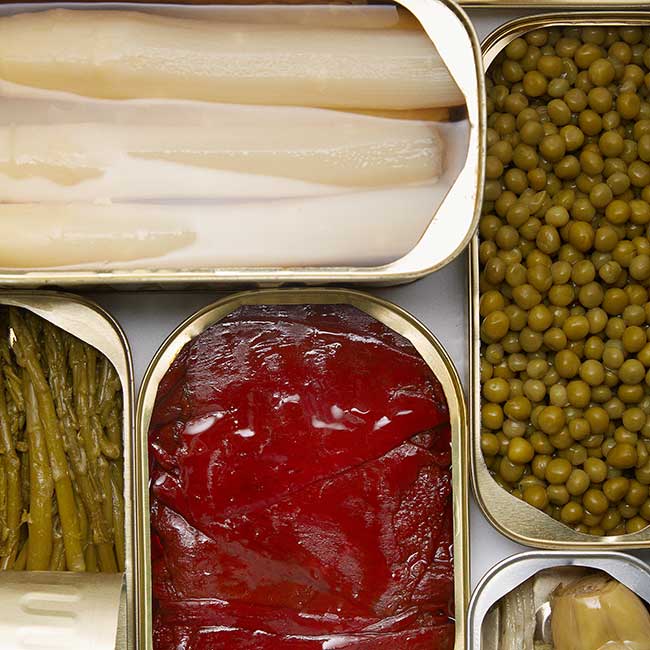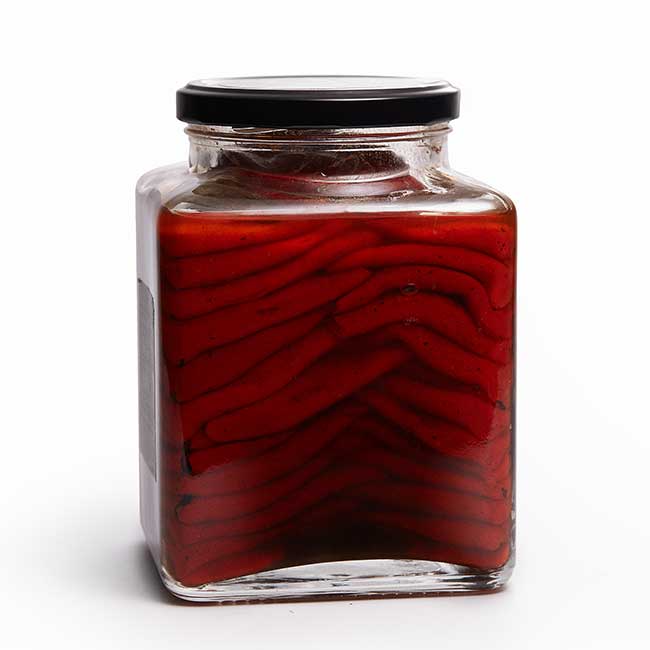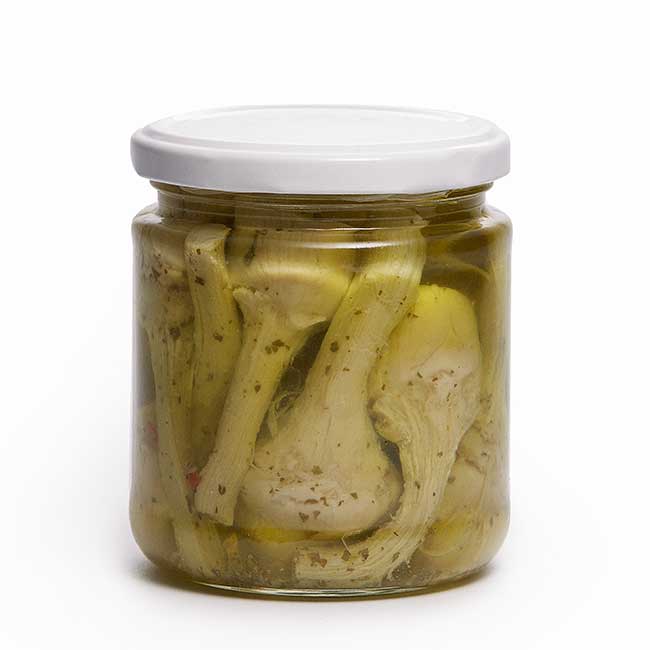.png.transform/rendition-xs/image_image%20(1).png)
Preserving the Seasons: Canned and Bottled Vegetables Provide a Taste of Spain Year-Round
With an enviable climate that allows for the nearly year-round production of fresh vegetables, Spain’s longstanding dedication to producing a wide range of top-quality vegetable preserves might seem like overkill. Even so, the ongoing popularity of these healthy products — both in and outside of Spain — is a tribute to their excellence. We don’t just need them, we love them.
Food conservation is nothing new on the Iberian Peninsula, given that ancient civilizations like the Phoenicians used drying and salting techniques to this end. Other millennia-old methods included immersing foods in animal fats, olive oil, or vinegar. However, today’s modern preservation techniques are based on the hermetic canning process introduced by Nicolas Appert in the late 18th century, and his later experiments with preserving food in glass jars. These were further developed some fifty years later thanks to Louis Pasteur’s research on microbes and food sterilization, and Spain quickly became one of the first countries in Europe to embrace these new preservation techniques for vegetables.
Despite technological advances over the years, the fundamentals of this process have remained virtually the same since the country’s first vegetable preserve factory opened in 1880. Likewise, these products continue to play a beloved role in Spain’s gastronomic tradition, while also finding a foothold among the chefs of the culinary avant-garde. The quality of these products has also made its mark on international markets, with some 41% of the total production of Spanish vegetable preserves currently exported (Mercasa, Alimentación en España, 2018, p. 143). Despite its emphasis on tradition, there is, of course, still room for innovation in this industry. Leading companies such as Conservas El Cidacos, Grupo Ángel Camacho and Grupo Ybarra Alimentación, often collaborate with research organizations like the Centro Nacional de Tecnología y Seguridad Alimentaria (National Center for Food Technology and Safety) in Navarre, or the Centro Tecnológico Nacional de la Conserva y Alimentación (National Technological Center Food Preservation and Nutrition) in Murcia.
From Murcia to the rest of Spain

The region of Murcia is the most prolific producer of these food preserves — representing 70% of market production (Mercasa, Alimentación en España, 2018, p. 142) — while other important production areas include the regions of Catalonia, Andalusia, Castile-León, Castile-La Mancha and Galicia. With regard to product type, whole and crushed tomatoes lead the way among all Spanish vegetable preserves, representing some 33.60% of the total volume of this market and 14.8% of its value.
However, the present trend indicates that artisanal, gourmet products, and especially those bearing Protected Denomination of Origin (PDO) or Protected Geographic Indication (PGI) designations are currently experiencing the highest percentage of growth. This is particularly true for three of the country’s most popular and most valued vegetable preserves: asparagus, artichokes and peppers, the most important varieties of which hold quality designations.
The Ebro River basin

Although Murcia dominates the market in terms of production, the Spanish vegetable preserve sector is defined in many ways by the exquisite products that come out of the area that is known as the Ebro basin, or the Ribera del Ebro. This fertile valley, which lies along the imposing Ebro River, straddles parts of La Rioja, Navarre and Aragón, regions where the traditional local canning and bottling industries have thrived for more than a century. It’s not surprising that Spain’s first vegetable preserves factory was founded in this area (La Rioja). In fact, the artisanal production methods that led to the early development of this local industry are still in large part followed today. The most obvious explanation is that one of the keys to this area’s excellent vegetable preserves has to do with the quality of the produce that is grown here.
Roasted peppers, Spanish tradition
Sales of canned and bottled Spanish peppers have risen by 6% between 2017 and 2018 (Mercasa, Alimentación en España, 2018, p. 142) — not that surprising given the variety and quality of these vegetables.
PGI Pimiento Riojano is one such product, the finest examples of which come from the Ebro River valley. These conical peppers can be red or green, and they are typically roasted, peeled and then canned in their own juices. Named for the local town of Lodosa in Navarre, PDO Pimiento de Piquillo de Lodosa peppers are unique in that they are virtually inedible when fresh but, once roasted, hand peeled and preserved, these short, red peppers take on a silky texture, and a sweetly aromatic and slightly piquant flavor.
Of course not all Spanish pepper preserves hail from this area. West of here, in the singular microclimate that defines the area of Castile-León known as Bierzo, PGI Pimiento Asado del Bierzo are so valued for their preserves (made after roasting or grilling the peppers and preserving them in their own juices) that the name of their designation refers directly to how they are prepared: asado, or roasted.
Asparagus from Spain for every season

Asparagus has been a culinary delicacy in Spain since at least the 18th century. The most famous canned or bottled version of this product is undoubtedly PGI Espárrago de Navarra, which comes from the Ebro basin, a production area that spans various parts of La Rioja, Aragón and Navarre. Novice buyers of this premium product would be stunned to see all the different versions of it. The preserves are classified by the size and number of stalks, the color, whether the stalks are whole or merely tips, and even by the type of packaging. Needless to say, the price varies almost as much. Approximately 2.1 million kilograms of the 2.3 million kilograms of asparagus that are produced in this quality designation are used for canning.
Another source of canned Spanish asparagus comes from the province of Granada in Andalusia. Some 250,000 kilograms of PDO Espárrago de Huétor-Tajar asparagus is produced here every year for both fresh consumption and preserves. This purplish-green variety is very similar to wild asparagus and comes from selected local varieties.
Spanish artichoke heaven
Like Spanish asparagus preserves, the production of artichoke preserves grew by approximately 4% in 2018, and this product was the third most exported Spanish vegetable preserve in 2017, at around 30,000 tons (Mercasa, Alimentación en España, 2018, pp. 142-143). But the true value of artichoke preserves lies in the fact that they are considered a treasured product on Spanish tables and in Spanish pantries. Perhaps the best-known variety is the PGI Alcachofa de Tudela artichokes from Navarre, 466,000 kilograms of which were destined for canning last year, as opposed to only 153,000 for fresh consumption. Another important variety is the PDO Alcachofa Benicarló artichokes grown in Castelló (Valencia), of which around 370,000 kilograms were sold fresh last year, while 310,000 kilograms were canned or bottled.
Other quality products that have found their niche in the vegetable preserves industry include highly seasonal and highly prized foods like PGI Grelos de Galicia (turnip greens), cardo (cardoons) and borage, the latter two of which are mainly canned in the Ebro basin (La Rioja, Navarre and Aragón), allowing us to enjoy their short seasons the whole year long.
Tradition, quality and innovation from Spain
When it comes to uniting quality and innovation in gourmet and artisanal products, certain producers immediately come to mind. It should come as no surprise that three of the well-established and best-known of these companies also make their home in the Ebro basin area: Navarrico (José Salcedo Soria S.L.) in the town of San Adrián (Navarre); Rosara, which is located just ten minutes down the road in Andosilla (Navarre); and La Catedral de Navarra, which is based in the town of Mendavia.
All three companies have strong roots in local food preserving traditions, while also investing in innovation in terms of product lines, packaging and production methods. They serve as international ambassadors for these excellent Spanish products by exporting their products to markets like the United States, Europe, Australia, New Zealand and South and Central America, among others.
Delicious flavors, high quality, and the convenience of enjoying Spanish vegetables year-round What more could you ask for?
Text: Adrienne Smith /@ICEX
Photos: LH Photoagency JC de Marcos / @ICEX.
Video: @ICEX

